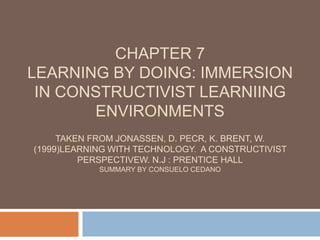Summary Cl Es
•Download as PPTX, PDF•
1 like•239 views
The document discusses constructivist learning environments (CLEs) and learning by doing. It defines CLEs as technology-based environments where students can work meaningfully on projects, exploring and experimenting while using tools and resources. Effective CLEs present students with an engaging but not overly defined problem to solve. They provide information banks with organized resources like texts and media to support problem-solving. CLEs also include cognitive tools to scaffold skills needed to complete tasks if students do not already possess them. The goal is for students to learn through meaningful projects that involve experimenting, constructing knowledge, conversing, and reflecting.
Report
Share
Report
Share

Recommended
More Related Content
What's hot
What's hot (20)
Lesson 7 IT FOR HIGHER THINKING SKILLS AND CREATIVITY

Lesson 7 IT FOR HIGHER THINKING SKILLS AND CREATIVITY
Code your own Game: the Case of Children with Hearing Impairments

Code your own Game: the Case of Children with Hearing Impairments
Educational Technology lesson 16 using project based multimedia learning

Educational Technology lesson 16 using project based multimedia learning
Project-based Learning Multimedia as a Teaching-Learning Strategy

Project-based Learning Multimedia as a Teaching-Learning Strategy
Instructional technology and multimedia for learning in the 21st century

Instructional technology and multimedia for learning in the 21st century
Viewers also liked
Viewers also liked (6)
Impress London: "How PR is Changing. And Staying the Same"

Impress London: "How PR is Changing. And Staying the Same"
CIPR Fifth Estate - Voluntary Sector Group: "Social Media - an introduction"

CIPR Fifth Estate - Voluntary Sector Group: "Social Media - an introduction"
Impress London: "Punching above your weight using social media"

Impress London: "Punching above your weight using social media"
Similar to Summary Cl Es
Similar to Summary Cl Es (20)
Summary Cl Es
- 1. Chapter 7 LEARNING BY DOING: IMMERSION IN CONSTRUCTIVIST LEARNIING ENVIRONMENTSTaken from Jonassen, D. Pecr, K. Brent, W. (1999)Learning with technology. A constructivist perspectivew. N.J : prentice hallsummary by Consuelo cedano
- 2. Some definitions Learning by doing: Engaging students in meaningful projects that require them to explore, experiment, construct, converse and reflect on what they are learning. Learning environments: CLEs are technology-based environments in which students can do something meaningful and useful. The technologies afford students the tools. Places where learners may work together and support each other as they use a variety of tools and information resources in their guided pursuit of learning goals and problem-solving activities.
- 3. Problem/project space The key to meaningful learning is ownership of a problem or learning goal, so it is important to present learners with an interesting, relevant and engaging problem to solve or project to develop. The problem should not be overly defined, so that some aspects of it can be determined by the learner The contextcan not be ignored The presentationof the problem has to be interesting, appealing and engaging
- 4. Information Resources When designing learning environments, you need to: Ask yourself what kinds of information will the learner need in order to make sense of the topic. Provide information banks, repositories of information about the subject, that includes the needed information. Information Banks: Include texts documents, graphics, sound resources, video, animations, etc Need to be accessible and useful Need to be organized in meaningful ways CLEs provide learner-selectable information just-in time to support some meaningful activity by the learners
- 5. Cognitive Tools It is necessary to support learners performance, by: Identifying the skills that are required to solve the problem or complete the mission. Identifying if those skills are likely to be possessed by the learners. If not, It´s necessary to build in cognitive tools that scaffold the learners’ abilities to perform those tasks-